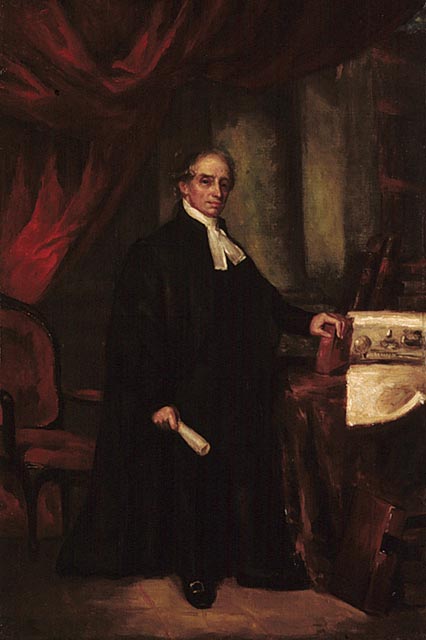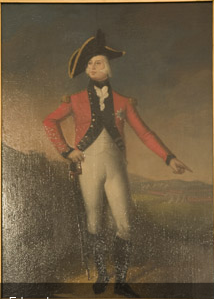|
Royal Nova Scotia Regiment
The Royal Nova Scotia Regiment (Nova Scotia Fencibles) was a battalion of infantry raised in 1793 to defend British interests in the colony of Nova Scotia during the Wars of the French Revolution. The unit was commanded by Colonel John Wentworth, the lieutenant-governor of the colony, throughout its existence. The Royal Nova Scotia Regiment (RNSR) had an undistinguished history through most of its existence, and saw very limited action, mostly in the role of marines, but did play an important role in the defense of Nova Scotia during these wars. Formation As tensions rose between the governments of Britain and Revolutionary France in early 1793, the British secretary of state for the colonies, Henry Dundas, wrote to Wentworth that the question of raising a provincial regiment for the defense of Nova Scotia was under consideration. In April, word arrived in Halifax, also from Dundas, that war had been declared, that all but 200 men of the British garrison were to be sent to t ... [...More Info...] [...Related Items...] OR: [Wikipedia] [Google] [Baidu] |
Sir John Wentworth, 1st Baronet
Sir John Wentworth, 1st Baronet (9 August 1737 – 8 April 1820) was the British colonial governor of New Hampshire at the time of the American Revolution. He was later also Lieutenant-Governor of Nova Scotia. He is buried in the crypt of St. Paul's Church in Halifax. Early years Wentworth was born in Portsmouth, New Hampshire, on August 9, 1737. His ancestry went back to some of the earliest settlers of the Province of New Hampshire, and he was a grandson of John Wentworth, who served as the province's lieutenant governor in the 1720s, a nephew to Governor Benning Wentworth, and a descendant of "Elder" William Wentworth. His father Mark was a major landowner and merchant in the province, and his mother, Elizabeth Rindge Wentworth, was also from the upper echelons of New Hampshire society. In 1751, he enrolled in Harvard College, receiving a bachelor's degree in 1755 and a master's degree in 1758. During his time at Harvard, he was a classmate and became a close friend ... [...More Info...] [...Related Items...] OR: [Wikipedia] [Google] [Baidu] |
Princes Lodge, Nova Scotia
Prince's Lodge is a neighbourhood located on the shore of Bedford Basin, between the communities of Rockingham and Bedford in Nova Scotia, Canada within the Halifax Regional Municipality on the Bedford Highway ( Trunk 2). History Prince's Lodge was named for the estate that Prince Edward, Duke of Kent resided in while in Halifax in from 1794 to 1800. In 1794, Prince Edward arrived to serve in Halifax as Commander-in-Chief of the King's forces in Nova Scotia and New Brunswick. He was accompanied by his French mistress Madame de Saint-Laurent. The Prince was often entertained by Sir John Wentworth, the Lieutenant-Governor of the colony, at his rural estate, the "Friar's Cell", as Wentworth called it, is an allusion to Shakespeare's Romeo and Juliet. The Prince liked it so much that Wentworth felt obliged to offer it to him during his stay in Halifax. Prince Edward accepted, and had the residence renovated into a two-storey (likely Palladian architecture mansion) and expanded, ... [...More Info...] [...Related Items...] OR: [Wikipedia] [Google] [Baidu] |
Partridge Island (Nova Scotia)
Partridge Island is a significant historical, cultural and geological site located near the mouth of Parrsboro Harbour and the town of Parrsboro on the Minas Basin, in Cumberland County, Nova Scotia, Canada. It attracts many visitors including sightseers, swimmers, photographers, hikers and amateur geologists. Partridge Island is actually a peninsula that is connected to the mainland by a sandbar isthmus. According to local legend, the isthmus was created during the Saxby Gale of 1869.Brown, Roger David. (2002) ''Historic Cumberland County South: Land of Promise''. Halifax: Nimbus Publishing Limited. The hiking trail to the top of the island affords scenic views of key landforms on the Minas Basin including Cape Blomidon, Cape Split and Cape Sharp. The nearby Ottawa House By-the-Sea Museum contains artifacts and exhibits illustrating the history of the former village at Partridge Island, which dates from the 1770s. Partridge Island is a favourite hunting ground for rockhounds bec ... [...More Info...] [...Related Items...] OR: [Wikipedia] [Google] [Baidu] |
Parrsboro, Nova Scotia
Parrsboro is a community located in Cumberland County, Nova Scotia, Canada. A regional service centre for southern Cumberland County, the community is also known for its port on the Minas Basin, the Ship's Company Theatre productions, and the Fundy Geological Museum. History Before the arrival of European settlers, Parrsboro was a portage point for Mikmaq travellers along the Minas Basin and Cumberland County river systems. The native inhabitants called the region "Awokum," meaning a 'short-cut' or 'passing-over point.' The first European settlers were the Acadians in 1670 at the western mouth of the Parrsboro Harbour, near Partridge Island. After they were expelled in 1755, they were replaced by New England Planters. The centre of settlement gradually shifted from Partridge Island to the sheltered estuary of the Parrsboro River where a harbour and surrounding mills grew. The settlement, at first named Mill Village, was renamed Parrsboro in honour of Nova Scotia Governo ... [...More Info...] [...Related Items...] OR: [Wikipedia] [Google] [Baidu] |
Royal Newfoundland Regiment
The Royal Newfoundland Regiment (R NFLD R) is a Primary Reserve infantry regiment of the Canadian Army. It is part of the 5th Canadian Division's 37 Canadian Brigade Group. Predecessor units trace their origins to 1795, and since 1949 Royal Newfoundland Regiment has been a unit of the Canadian Army. During the First World War the battalion-sized ''Newfoundland Regiment'' was the only North American unit to fight in the Gallipoli campaign of 1915. Later in the war the regiment was virtually wiped out at Beaumont Hamel on July 1, 1916, the first day of the Battle of the Somme, but was rebuilt and continued to serve throughout France and Belgium until the armistice, serving as part of the British Army of the Rhine in 1919. In December 1917, George V bestowed the regiment with the right to use the prefix royal before its name. It was the only military unit to receive this honour during the First World War. During the Second World War, the Newfoundland Militia was raised for defe ... [...More Info...] [...Related Items...] OR: [Wikipedia] [Google] [Baidu] |
Colony Of Newfoundland
Newfoundland Colony was an English and, later, British colony established in 1610 on the island of Newfoundland off the Atlantic coast of Canada, in what is now the province of Newfoundland and Labrador. That followed decades of sporadic English settlement on the island, which was at first seasonal, rather than permanent. It was made a Crown colony in 1824 and a Dominion in 1907. Its economy collapsed during the Great Depression of the 1930s, and Newfoundland relinquished its dominion status, effectively becoming once again a colony governed by appointees from the Colonial Office in Whitehall in London. In 1949, the colony voted to join Canada as the Province of Newfoundland. History Indigenous people like the Beothuk (known as the ''Skræling'' in Greenlandic Norse), and Innu were the first inhabitants of Newfoundland and Labrador. During the late 15th century, European explorers like João Fernandes Lavrador, Gaspar Corte-Real, John Cabot, Jacques Cartier and others b ... [...More Info...] [...Related Items...] OR: [Wikipedia] [Google] [Baidu] |
New Brunswick, Canada
New Brunswick (french: Nouveau-Brunswick, , locally ) is one of the thirteen provinces and territories of Canada. It is one of the three Maritime provinces and one of the four Atlantic provinces. It is the only province with both English and French as its official languages. New Brunswick is bordered by Quebec to the north, Nova Scotia to the east, the Gulf of Saint Lawrence to the northeast, the Bay of Fundy to the southeast, and the U.S. state of Maine to the west. New Brunswick is about 83% forested and its northern half is occupied by the Appalachians. The province's climate is continental with snowy winters and temperate summers. New Brunswick has a surface area of and 775,610 inhabitants (2021 census). Atypically for Canada, only about half of the population lives in urban areas. New Brunswick's largest cities are Moncton and Saint John, while its capital is Fredericton. In 1969, New Brunswick passed the Official Languages Act which began recognizing French as an of ... [...More Info...] [...Related Items...] OR: [Wikipedia] [Google] [Baidu] |
Prince Edward, Duke Of Kent And Strathearn
Prince Edward, Duke of Kent and Strathearn, (Edward Augustus; 2 November 1767 – 23 January 1820) was the fourth son and fifth child of King George III. His only legitimate child became Queen Victoria. Prince Edward was created Duke of Kent and Strathearn and Earl of Dublin on 23 April 1799''Whitehall, 23 April 1799.''The King has been pleased to grant to His Most Dearly-Beloved Son Prince Edward, and to the Heirs Male of His Royal Highness's Body lawfully begotten, the Dignities of Duke of the Kingdom of Great Britain, and of Earl of the Kingdom of Ireland, by the Names, Styles, and Titles of Duke of Kent, and of Strathern, in the Kingdom of Great Britain, and of Earl of Dublin, in the Kingdom of Ireland. and, a few weeks later, appointed a General and commander-in-chief of British forces in the Maritime Provinces of North America. On 23 March 1802, he was appointed Governor of Gibraltar and nominally retained that post until his death. The Duke was appointed Field-Marshal of ... [...More Info...] [...Related Items...] OR: [Wikipedia] [Google] [Baidu] |
4th Regiment Of Foot , or The Fourth of July
{{Disambiguation ...
Fourth or the fourth may refer to: * the ordinal form of the number 4 * ''Fourth'' (album), by Soft Machine, 1971 * Fourth (angle), an ancient astronomical subdivision * Fourth (music), a musical interval * ''The Fourth'' (1972 film), a Soviet drama See also * * * 1/4 (other) * 4 (other) * The fourth part of the world (other) * Forth (other) * Quarter (other) * Independence Day (United States) Independence Day (colloquially the Fourth of July) is a federal holiday in the United States commemorating the Declaration of Independence, which was ratified by the Second Continental Congress on July 4, 1776, establishing the United States ... [...More Info...] [...Related Items...] OR: [Wikipedia] [Google] [Baidu] |
84th Regiment Of Foot (Royal Highland Emigrants)
The 84th Regiment of Foot (Royal Highland Emigrants) was a British regiment in the American Revolutionary War that was raised to defend present day Ontario, Quebec and Atlantic Canada from the constant land and sea attacks by American Revolutionaries. The 84th Regiment was also involved in offensive action in the Thirteen Colonies; including North Carolina, South Carolina, Georgia, Virginia and what is now Maine, as well as raids upon Lake Champlain and the Mohawk Valley. The regiment consisted of 2,000 men in twenty companies. The 84th Regiment was raised from Scottish soldiers who had served in the Seven Years' War and stayed in North America. As a result, the 84th Regiment had one of the oldest and most experienced officer corps of any regiment in North America. The Scottish Highland regiments were a key element of the British Army in the American Revolution. The 84th Regiment was clothed, armed and accoutred the same as the Black Watch, with Lieutenant Colonel Allan Maclean c ... [...More Info...] [...Related Items...] OR: [Wikipedia] [Google] [Baidu] |





GeorgeDawe.jpg)
.png)